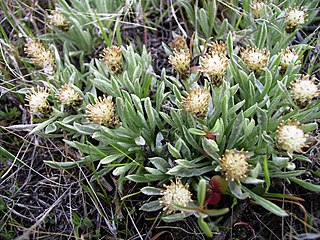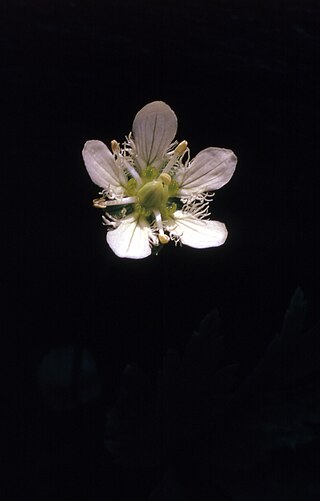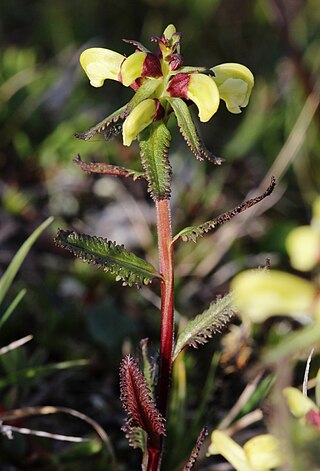
Pedicularis is a genus of perennial green root parasite plants currently placed in the family Orobanchaceae.

Pedicularis furbishiae, or Furbish's lousewort, is a perennial herb found only on the shores of the upper Saint John River in Maine and New Brunswick. Furbish's lousewort was first recognized as a new species by Maine naturalist and botanical artist Kate Furbish in 1880. It is considered an endangered species in the United States and Canada, and is threatened by habitat destruction, as well as riverside development, forestry, littering and recreational use of the riverbank. It was formerly in the family Scrophulariaceae, but is now placed in the family Orobanchaceae. Once thought to be extinct, it is considered a Lazarus taxon.

Pedicularis groenlandica is a showy flowering plant in the family Orobanchaceae commonly known as elephant's head, little pink elephant, elephantella, or similar common names inspired by the resemblance of the flower to the head of an elephant. It is also less commonly known as butterfly tongue for the long beak on the flower. Like many other plants in genus Pedicularis, it is a parasitic plant and depends on host plants to survive.

Antennaria dimorpha is a North American species of flowering plants in the family Asteraceae known by the common names low pussytoes or gray cushion pussytoes. It is native to western Canada and the western United States as far south as Riverside County in California and Rio Arriba County in New Mexico. It is generally found in dry areas. There are historical records of the species formerly occurring in northwestern Nebraska, but these populations appear now to be gone.

Campanula scabrella is a species of bellflower known by the common name rough bellflower. It is native to the mountains of the western United States, where it grows in talus and other rocky alpine habitat. This is a tough perennial herb growing in a clump from a woody rhizome and rarely exceeding 5 centimeters in height. The stiff leaves are linear to narrowly oval in shape and about 3 centimeters long, borne on winged petioles. The leaves are covered with very short appressed pale hairs. The small funnel-shaped flower is just under a centimeter long and pale blue or lavender in color, arising from the leaf clump on an erect pedicel about a centimeter tall.

Lomatium canbyi is a species of flowering plant in the carrot family known by the common name Canby's biscuitroot. It is native to the Pacific Northwest of the United States and northeast California, where it grows east of the Cascade ridge in sagebrush-covered plateau habitat and barren flats.

Lomatium columbianum is a perennial herb of the family Apiaceae known by the common names purple leptotaenia and Columbia desert parsley. It is endemic to the U.S. states of Oregon and Washington, mostly along the Columbia River east of the Cascades.

Parnassia fimbriata is a species of flowering plant in the family Celastraceae known by the common name fringed grass of Parnassus. It was first described by Charles Konig. It is native to western North America from Alaska and northwestern Canada to the southern Rocky Mountains, where it is a plant of alpine and subalpine environments, usually in wet areas. Despite the common name, this is not a true grass.

Pedicularis centranthera is a species of flowering plant in the family Orobanchaceae known by the common names dwarf lousewort and Great Basin lousewort. It is native to the western United States from eastern Oregon and California to Colorado and New Mexico, where it grows in sagebrush and other basin and plateau habitat. It is a perennial herb producing several short stems a few centimeters tall from a basal caudex. The leaves are up to 20 centimeters long, lance-shaped and divided into many overlapping toothed, wrinkled, or fringed lobes. The inflorescence is a short raceme bearing many long, protruding, club-shaped flowers. Each flower may exceed 4 centimeters in length and is white or pale purple with dark purple tips on the wide ends of its upper and lower lips. The sepals of the flowers are shorter and hairy. The fruit is a capsule around centimeter long containing seeds with netlike surfaces.

Pedicularis contorta is a species of flowering plant in the family Orobanchaceae known by the common names coiled lousewort and curved-beak lousewort. It is native to western North America, including southwestern Canada and the northwestern United States, where it grows in moist mountainous habitat, such as bogs, shady forests, and meadows. It is a perennial herb producing one or more stems up to 40 centimetres (16 in) tall from a caudex. The leaves are up to 18 centimetres (7.1 in) long, lance-shaped to oblong, and divided into many linear lobes which may be toothed or smooth-edged. The inflorescence is a raceme of flowers occupying the top of the stem. Each flower is a centimeter long or slightly longer, white to yellowish in color, and divided into a coiled or curved beak-like upper lip and a flat, three-lobed lower lip. The fruit is a capsule up to a centimeter long containing seeds with netted surfaces.
Pedicularis howellii is an uncommon species of flowering plant in the family Orobanchaceae known by the common name Howell's lousewort. It is endemic to the Siskiyou Mountains of the Klamath Range in southern Oregon and northern California, where it grows on the edges of coniferous forests. This is a perennial herb producing one or more stems up to 45 centimetres (18 in) tall from a long caudex. The leaves are up to 20 centimetres (8 in) long, lance-shaped, and divided into many toothed oval lobes; those higher on the stem may be unlobed. The basal leaves fall away early. The inflorescence is a small raceme of flowers occupying the top of the stem. Each white to light purple flower is up to one centimetre long and is sickle-shaped, with a curved beak-like upper lip and a three-lobed lower lip which may be tucked into the hairy mass of sepals. The plant is pollinated by bumblebees including Bombus mixtus. Between the flowers are hairy to woolly triangular bracts. The fruit is a capsule just under a centimeter long containing seeds with netted surfaces.
Allium dictuon is a species of wild onion known by the common name Blue Mountain onion. It is native to a small section of the Blue Mountains straddling the border between southeastern Washington and northeastern Oregon in the United States. It grows in Columbia, Garfield and Walla Walla Counties in Washington, plus Umatilla and Wallowa Counties in Oregon.

Lomatium greenmanii is a rare species of flowering plant in the carrot family known by the common names Greenman's desertparsley and Greenman's biscuitroot. It is endemic to Oregon in the United States, where it is found only in the Wallowa Mountains of Wallowa County.

Pedicularis lanata is a species of flowering plant in the family Orobanchaceae. It is native to Canada and Alaska. Its common names include woolly lousewort and bumble-bee flower.

Balsamorhiza hookeri is a North American species of perennial plant in the family Asteraceae. It grows in the Great Basin and neighboring regions in the Western United States. It is found in Washington, Oregon, California, Idaho, Nevada, Utah, and Arizona.

Lathyrus pauciflorus, known by the common name of few flowered peavine, is a perennial plant species in the Fabaceae family.

Pedicularis bracteosa also known as bracted lousewort is a flowering deciduous perennial plant with alternating cauline leaves that are linear/oblong to lanceolate, approximately 1 to 7 cm long. It has fibrous roots and grows to approximately 1 meter high. Its flowers form in densely clustered spike raceme, and range in color from yellow to bronze to red to purple. Its distribution is found in western North America including New Mexico, Colorado, Montana, mountainous parts of Washington and California, and in British Columbia.

Castilleja elmeri is a species of flowering plant in the family Orobanchaceae with the common name Elmer's paintbrush. As with most Castilleja species, this is a facultative root hemiparasite and will usually be seen growing close to a host plant.

Pedicularis lapponica, the Lapland lousewort, is a perennial hemiparasitic species of flowering plant in the family Orobanchaceae with yellow to creme coloured flowers.

Tauschia stricklandii is a perennial herb in the Apiaceae family with the common name Strickland's umbrella-wort. It is a narrow endemic that is found mostly in meadows around Mount Rainier.





















